Store your homemade soap in a cool, dark area away from direct sunlight using breathable packaging like kraft paper or muslin. Place bars on open-air shelving with at least half an inch between each to guarantee proper airflow. Group similar scents together to prevent fragrance contamination. Use greaseproof paper beneath soaps and implement a first-in, first-out rotation system. Maintain temperatures between 60-80°F and control humidity with dehumidifiers when needed. These storage techniques will maximize your soap's shelf life and quality.
Creating the Perfect Curing Room for Soap Longevity
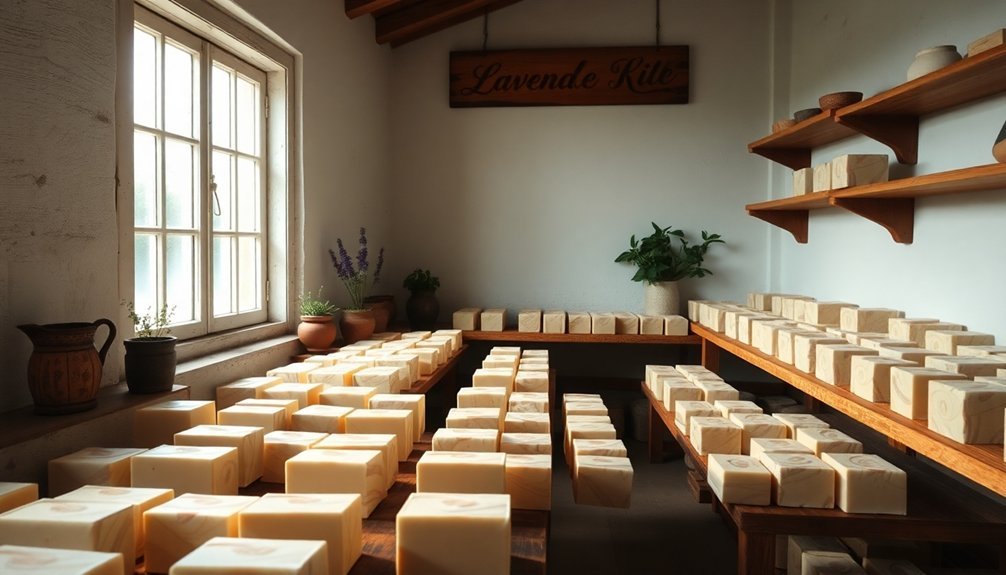
While many soap makers focus on ingredients and techniques, establishing a proper curing environment is equally essential for creating high-quality, long-lasting soap. Your curing room should be located away from high-humidity areas like bathrooms and kitchens.
Great soap isn't just about what goes in—where it cures matters just as much for quality and longevity.
Choose a cool space with good air circulation to facilitate water evaporation and proper hardening. Maintaining temperature between 60-80°F creates optimal conditions for the curing process. Keep soap bars out of direct sunlight to prevent degradation of colors and essential oils.
Install shelving or racks to guarantee bars aren't overcrowded, allowing air to flow around each piece. If you're in a humid climate, consider using dehumidifiers to maintain ideal conditions.
Line your storage surfaces with greaseproof paper to prevent contamination. Remember to label each batch with its production date and recipe for proper tracking.
Open-Air Shelving Systems That Maximize Airflow
Open-air shelving systems offer you superior ventilation for your homemade soap, allowing air to circulate fully around each bar for ideal curing.
You can create effective DIY solutions using wire cooling racks, plastic mesh shelving, or wooden slat designs that promote consistent airflow throughout your soap collection. For a more mobile solution, consider repurposing kitchen islands with open shelving like those found in the Spence Wood Kitchen Island, which offers two levels of lower shelving perfect for soap curing.
When arranging your bars, maintaining at least half an inch between each soap prevents moisture trapping and guarantees even drying across all surfaces.
Ventilated Rack Advantages
Proper airflow stands as the cornerstone of successful soap storage, making ventilated racks an essential investment for any soap maker. These specialized racks allow air to circulate from all directions, ensuring your soap cures properly and maintains its quality over time.
Baker's racks are particularly effective due to their vertical stacking ability, which maximizes space efficiency while providing excellent airflow. If you choose metal racks, opt for coated versions to prevent rust that could compromise your soap's quality. Plastic storage baskets provide a stackable alternative option that maintains necessary airflow while making organization easier.
Orchard racks offer both functionality and visual appeal for organized storage.
The benefits extend beyond aesthetics—proper ventilation extends shelf life, preserves fragrances, prevents orange spots caused by metal reactions, and reduces the risk of rancidity.
Your soap will remain fresh, maintaining both scent and texture through its entire lifespan.
DIY Airflow Solutions
Creating your own airflow-optimized storage system needn't be complicated or expensive. Repurpose wire racks or oven racks for superior air circulation around your curing soaps.
For enhanced ventilation, position small fans nearby or place your storage in naturally breezy areas like attics or breezeways. Maintaining adequate air circulation helps prevent spoilage and ensures proper drying of soap bars.
In humid environments, consider adding a dehumidifier to prevent moisture buildup that can affect your soap's quality. You can craft simple DIY circulation systems using cardboard dividers or mesh platforms that allow air to flow freely between soap bars.
For compact spaces, foldable drying racks offer flexibility when not in use. Open windows periodically to introduce fresh air to your storage area.
Remember that proper airflow is essential for curing and maintaining the quality of your handcrafted soaps.
Distance Between Bars
The strategic placement of soap bars on shelving systems can dramatically impact their curing process and longevity. You'll want to space your bars so they don't touch each other, allowing air to circulate freely around each one. For multi-layer storage, place paper towels between layers to prevent direct contact and moisture transfer. Bakers racks provide excellent ventilation for soap curing due to their open design.
| Spacing Approach | Benefit |
|---|---|
| 1" between bars | Prevents scent transfer |
| Standing bars on end | Maximizes precious shelf space |
| Alternating pattern | Creates natural airflow channels |
| Single layer spacing | Eliminates DOS risk entirely |
Some soap shapes naturally stand upright, further increasing air exposure. By maximizing rack utilization through stackable storage options, you'll create efficient systems that keep your homemade soaps in perfect condition while making the most of your available space.
Temperature and Humidity Control for Optimal Soap Storage
Maintaining ideal temperature and humidity levels stands as the cornerstone of effective soap storage. Your handcrafted bars need protection from extreme conditions that can cause melting, discoloration, or degradation.
Keep them in cool, dry places away from direct sunlight and heat sources to preserve their quality.
For best results:
- Store soap below 80°F (27°C) in well-ventilated areas to prevent melting and fragrance deterioration.
- Use dehumidifiers in humid environments to reduce moisture that can cause orange spots.
- Choose storage locations outside bathrooms and kitchens where humidity fluctuates dramatically.
- Allow consistent airflow around each bar by using open shelving or cardboard boxes with ventilation holes.
Temperatures exceeding 85°F significantly increase the risk of developing Dreaded Orange Spots in your soap during storage.
Climate considerations matter too—subtropical regions require extra humidity management through breathable containers and regular monitoring.
Breathable Packaging Materials for Preserving Handcrafted Soaps
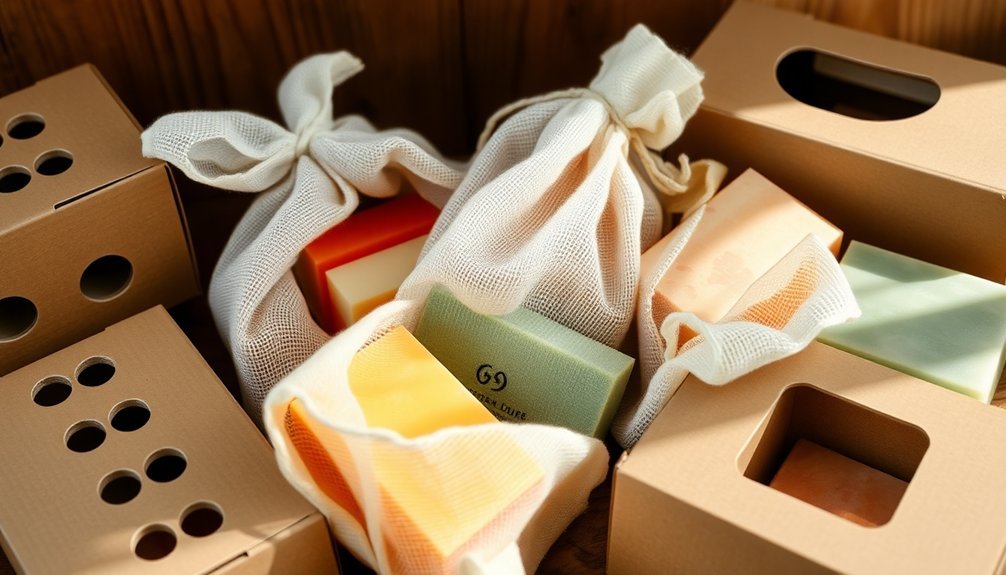
When storing your homemade soaps, breathable materials like paper wraps and bags allow moisture to escape while preserving fragrance.
Muslin and cheesecloth options provide excellent air circulation, preventing the saponification issues that can occur with airtight packaging.
Cardboard sleeves offer both protection and sustainability, making them an ideal choice for eco-conscious crafters who want to maintain their soap's quality. For optimal environmental impact, consider using sleeves made from recycled cardboard that is free from bleach, dyes, and plastic components.
Paper Wraps and Bags
Paper wraps and bags represent one of the most sustainable and effective solutions for storing handcrafted soaps. They provide essential breathability that prevents moisture buildup and mold growth while helping retain your soap's fragrance and extending its shelf life.
You'll find several advantages when using paper packaging for your homemade soaps:
- Eco-friendly composition – Biodegradable materials reduce environmental impact compared to plastic alternatives.
- Cost-effectiveness – Lightweight nature reduces transportation expenses and wholesale purchases often come with discounts.
- Customization options – Kraft, tissue, wax, and patterned papers offer unique branding opportunities.
- Quality preservation – Air circulation keeps soaps fresh while protecting them from dust and contaminants. The paper material helps prevent bacteria growth and leads to longer shelf life due to better preservation of the soap's quality.
For best results, store your paper-wrapped soaps in cool, dry areas with good air circulation.
Muslin and Cheesecloth
Natural fabric options like muslin and cheesecloth offer excellent breathability for your handmade soaps while adding rustic charm to your packaging.
These materials allow ideal air circulation around your soap bars, helping them cure properly and develop hardness while preventing moisture buildup that can lead to DOS (Dreaded Orange Spots).
Unlike plastic wraps that trap moisture, these fabrics let your soap breathe freely, extending shelf life greatly.
Muslin, being stronger than cheesecloth, provides better protection while maintaining necessary airflow. Community experiments have shown that soaps stored in muslin bags displayed minimal DOS compared to naked soap stored without protection.
Both options work best for cold and hot process soaps stored in cool, dry places away from sunlight.
You'll appreciate their reusability and sustainability—simply wash and dry them between uses.
For gifting or selling your creations, these natural wrappings add an appealing aesthetic touch that plastic can't match.
Cardboard Sleeve Options
Cardboard sleeves offer an exceptional balance of protection and breathability for your handcrafted soaps, making them a popular choice among experienced soapmakers.
These eco-friendly containers allow proper air circulation while shielding your creations from direct sunlight and environmental contaminants.
When using cardboard sleeves, you'll benefit from:
- Customization opportunities – Design sleeves that highlight your soap's unique scents and ingredients
- Space efficiency – Stack boxes neatly to maximize storage without maximizing storage
- Organization – Separate and label different varieties for easy identification
- Scent preservation – Boxes with air holes help maintain essential oil fragrances longer
For best results, store your sleeved soaps in cool, dry environments and guarantee the cardboard isn't sealed too tightly, which could trap unwanted moisture. Placing paper towels between layers of sleeved soap can prevent direct contact and protect your products from potential damage.
Preventing Scent Contamination Between Different Soap Varieties
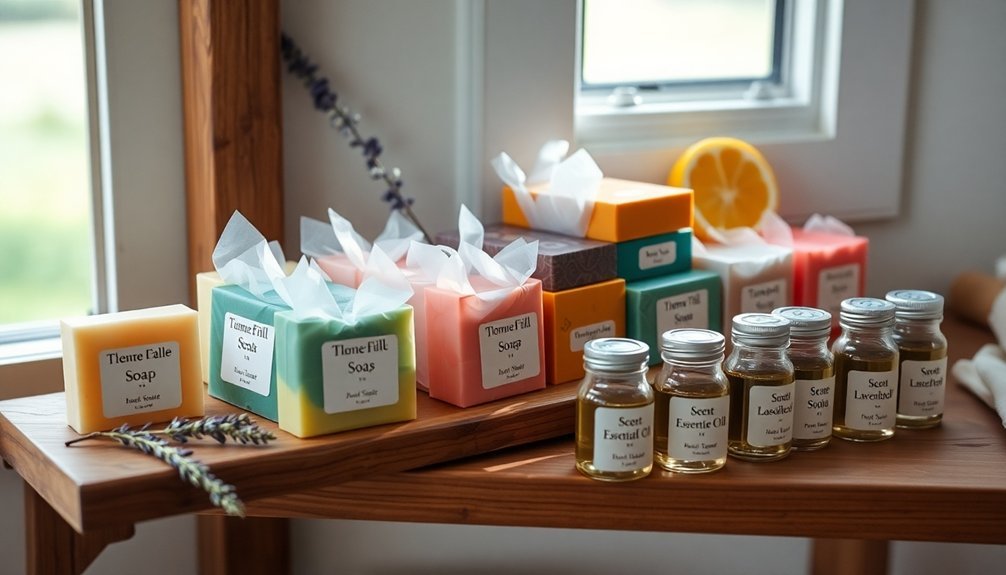
When you've crafted multiple varieties of homemade soap with distinct fragrances, keeping those scents from mingling becomes an essential challenge. Proper air circulation is your first defense—store soaps in well-ventilated areas where fresh air can flow around each bar.
Group similar scent families together and use barriers like paper towels or cotton cloth between different varieties. Always leave space between soap bars to prevent direct contact and scent transfer. Storing soaps too close together can lead to what soapmakers call scent fatigue in closed environments.
Consider using glass containers rather than plastic, which can absorb and transfer fragrances. For long-term storage, lidded containers work best, particularly if you add a small amount of the original fragrance on a cotton ball inside.
This technique not only prevents cross-contamination but also helps maintain each soap's unique scent profile over time.
Seasonal Adjustments for Soap Storage in Changing Climates
As seasons shift throughout the year, your homemade soap requires different storage considerations to maintain its quality and longevity.
Climate fluctuations can greatly impact your soap's texture, scent, and shelf life if not properly managed.
Your handcrafted soaps respond dramatically to environmental changes, requiring mindful storage to preserve their finest qualities.
Adapt your storage approach with these seasonal strategies:
- Summer Protection – Move soap to cooler, darker areas of your home to prevent softening or melting during hot weather.
- Winter Care – Keep soap away from freezing temperatures which can affect hardness and create cracks.
- Humidity Management – Use dehumidifiers during rainy or muggy seasons to prevent moisture absorption. Running a fan over your soap collection can significantly reduce curing time in high humidity environments.
- Ventilation Adjustment – Increase airflow during humid periods but reduce it during extremely dry conditions.
Don't forget to regularly check your soap throughout seasonal changes to catch any issues early.
Space-Efficient Storage Solutions for Soap Makers
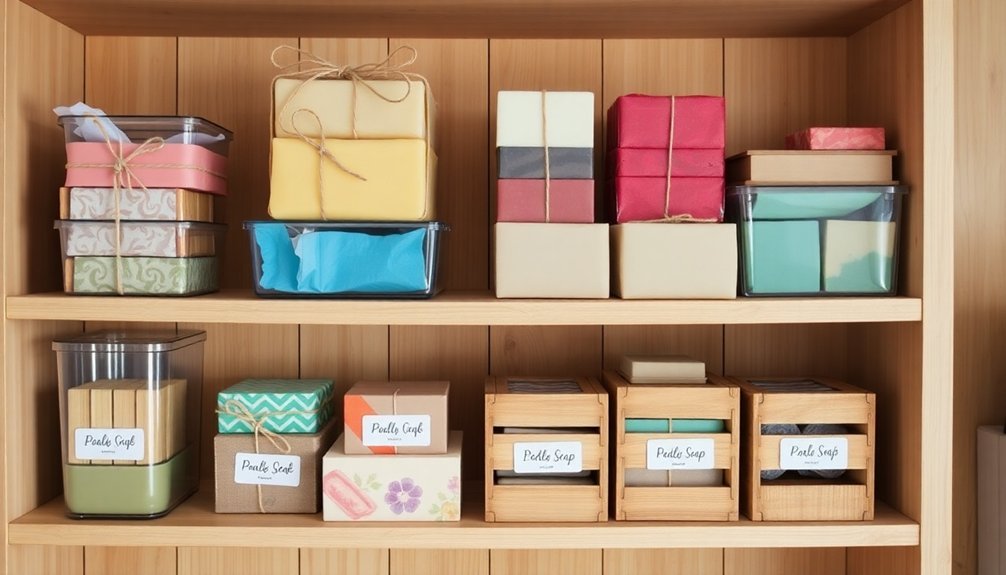
You'll maximize your soap-making space with vertical stacking systems that utilize wall space rather than valuable floor area.
Multi-tier soap racks allow you to cure dozens of bars simultaneously while maintaining proper air circulation in a minimal footprint.
Compact drawer organization, especially with dividers and labeled sections, keeps your molds, tools, and finished products neatly arranged and easily accessible.
For those preferring wall-mounted options, containers like Ikea Grundtal feature magnetic bottoms that eliminate the need for shelf space while ensuring your soaps remain easily accessible.
Vertical Stacking Systems
Three key challenges face most soap makers: limited space, the need for proper air circulation during curing, and keeping inventory organized.
Vertical stacking systems offer elegant solutions to these problems by utilizing your ceiling height instead of floor space.
When implementing vertical storage in your soap making area, consider:
- Wire shelving and baker's racks – These provide excellent airflow while maximizing vertical space.
- Wall-mounted solutions – Spice racks work perfectly for essential oils and fragrance storage.
- Stackable plastic bins – Keep cured soap dust-free while conserving space.
- Overhead shelving – Utilize unused ceiling space for seasonal or less-frequently used supplies. Rolling carts provide mobility for frequently accessed supplies while maintaining an organized workspace.
For ideal results in humid environments, choose plastic-coated wire racks or nylon mesh systems that prevent moisture buildup while maintaining proper ventilation during the curing process.
Multi-Tier Soap Racks
Multi-tier soap racks represent the pinnacle of storage efficiency for serious soap makers who need to maximize their available space.
These vertical organizers utilize height rather than floor area, allowing you to store considerably more product in the same footprint.
When selecting a rack, consider materials carefully. Stainless steel offers durability in humid environments, while wood provides rustic charm but needs maintenance.
Look for designs with proper drainage features and adequate spacing between tiers to promote air circulation. Proper spacing enables soap to dry completely between uses, preventing premature dissolution and extending the lifespan of your handcrafted bars.
You'll appreciate how these racks keep your soap varieties organized and accessible. The tiered display makes inventory management simpler and creates an attractive presentation.
For wall-mounted options, guarantee secure installation to prevent accidents. Clean your racks regularly to prevent moisture buildup that could affect your soap quality.
Compact Drawer Organization
While multi-tier racks handle your finished products beautifully, compact drawer organization offers the perfect complement for managing your soap-making supplies.
By designating specific drawers for different categories and utilizing vertical space with stackable containers, you'll transform cluttered spaces into efficient workstations.
Maximize your drawer storage with these proven techniques:
- Install adjustable drawer dividers to create customized compartments for fragrances, colorants, and small tools.
- Use magnetic strips along drawer sides to keep metal implements secure and easily accessible.
- Implement a clear labeling system so you'll never waste time hunting for specific ingredients.
- Store heavier items in the back of deep drawers and frequently used supplies toward the front for easy retrieval.
Regular decluttering keeps your system functioning effectively and saves precious creative time. Consider organizing silicone molds by categorizing and labeling them, which makes accessing the right mold much easier during production.
Natural Materials That Enhance Soap Preservation
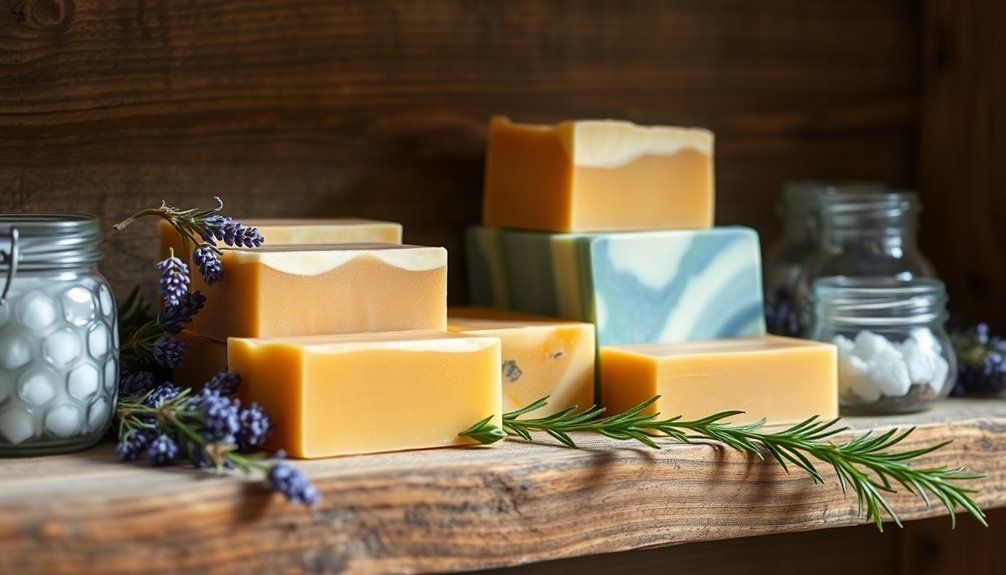
When crafting homemade soap, incorporating the right natural materials can greatly extend your product's shelf life without resorting to harsh chemicals.
Plant-derived preservatives like caprylyl glycol (found in Cap-5) offer effective, paraben-free protection against microbial growth.
Nature's defense in a bottle – plant-based preservatives like caprylyl glycol protect your homemade soap while keeping it chemical-free.
Vitamin E oil isn't a traditional preservative but helps prevent oils from turning rancid by slowing oxidation.
Consider adding sodium chloride (salt), cane sugar, or sodium lactate to bind water and reduce microbial activity. These ingredients act as natural humectants while enhancing preservation.
Glycerin serves a dual purpose – it attracts moisture to your skin while reducing available water for bacteria.
For enhanced protection, chelating agents like sodium citrate bind minerals that might otherwise interfere with your preservative system.
When combining these natural materials strategically, you'll create soaps that remain fresh longer without synthetic additives.
Understanding water activity levels helps explain why liquid soaps with their high water content (80-90%) require more preservation than solid bar soaps.
Protecting Colorful Soaps From Light Degradation
Have you ever noticed how your vibrant, handcrafted soaps gradually lose their luster when exposed to light? This color degradation isn't inevitable—you can preserve those beautiful hues with proper storage techniques.
Light exposure, especially direct sunlight, is the primary culprit behind fading colors in your artistic soap creations. To protect your colorful soaps:
- Store bars in a cool, dry place away from windows and direct light sources.
- Use breathable containers with ventilation holes rather than sealed boxes.
- Consider wrapping individual bars in acid-free tissue paper for added protection.
- Display your soaps in rotation, limiting each bar's exposure time in high-light areas.
Quality colorants specifically designed for soap-making will naturally offer better stability, but even these need protection from environmental factors that accelerate fading. Remember that prolonged heat exposure can also significantly degrade colors in your soaps, leading to premature fading beyond what light alone might cause.
Proper Rotation Systems for Managing Soap Inventory
As your soap-making hobby evolves into a serious craft, managing your inventory becomes essential for maintaining product quality and minimizing waste. Implementing a FIFO (first-in, first-out) rotation system guarantees older soaps are sold or used before newer batches, preserving freshness and customer satisfaction.
Organize your storage area with clear labeling that includes production dates. Place newer soaps at the back of shelves and move older inventory forward for easy access. This organization helps prevent product obsolescence and ensures customers always receive your soaps at peak quality.
Consider using ventilated plastic bins or slatted wooden racks that allow proper air circulation while keeping products organized.
For larger operations, inventory management software can automate your rotation system, sending alerts when products are approaching their ideal use-by dates. This technology eliminates guesswork and helps you maintain consistent quality while reducing potential losses from expired products.
Frequently Asked Questions
How Long Can Properly Stored Homemade Soap Remain Usable?
Your properly stored homemade soap will typically remain usable for about one year. You'll notice longer shelf life if you've used basic oils rather than fancy ones and maintained proper ventilation.
Can I Freeze Soap Bars to Extend Their Shelf Life?
Freezing isn't recommended for soap bars. It can cause brittleness and moisture problems when thawed. You'll get better results by storing your soap in a cool, dry place with good air circulation instead.
Do Essential Oil Soaps Require Different Storage Methods Than Unscented Bars?
Essential oil soaps don't typically need different storage than unscented bars. You'll still want to keep them in cool, dry places with good air circulation, though some delicate fragrances might benefit from extra light protection.
Is Wooden Shelving Better Than Plastic for Long-Term Soap Storage?
Wood isn't necessarily better than plastic for soap storage. Your choice depends on aesthetics and needs. Wood offers natural beauty but requires sealing against moisture, while plastic provides low-maintenance, moisture-resistant protection without special treatment.
How Can I Tell if My Stored Soap Has Gone Bad?
You'll know your soap is spoiled if it has a rancid smell, discolored spots (especially orange or yellow), slimy texture, visible mold, or doesn't lather properly. Check for these signs regularly.
In Summary
By implementing these storage solutions, you'll extend your homemade soap's shelf life while preserving its quality. Whether you're creating a dedicated curing space, investing in proper shelving, or managing environmental factors, proper storage isn't just practical—it's essential to your craft. Remember, your soaps deserve the same care in storage that you put into making them. Your attention to these details will reward you with beautiful, fragrant soaps ready whenever you need them.

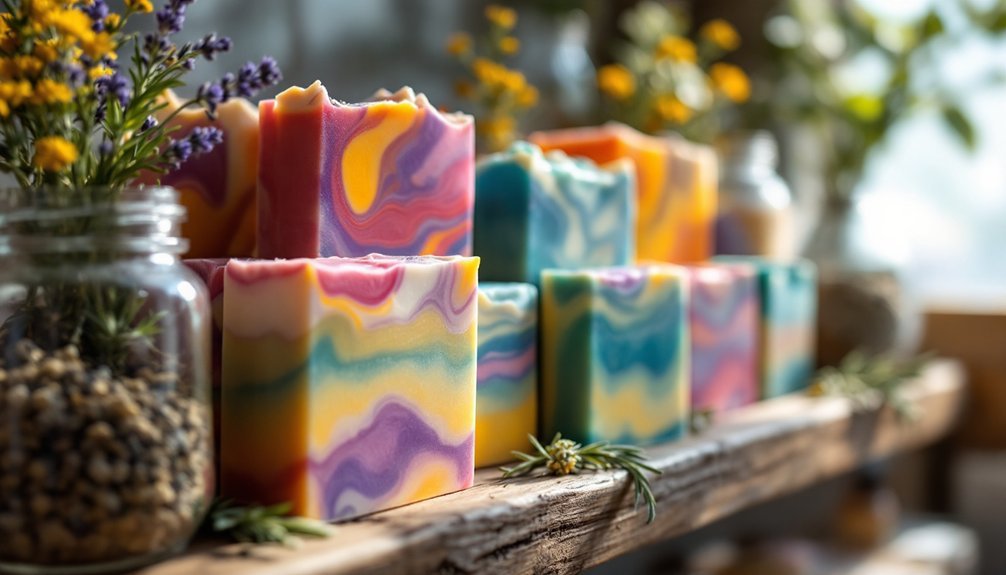



Leave a Reply